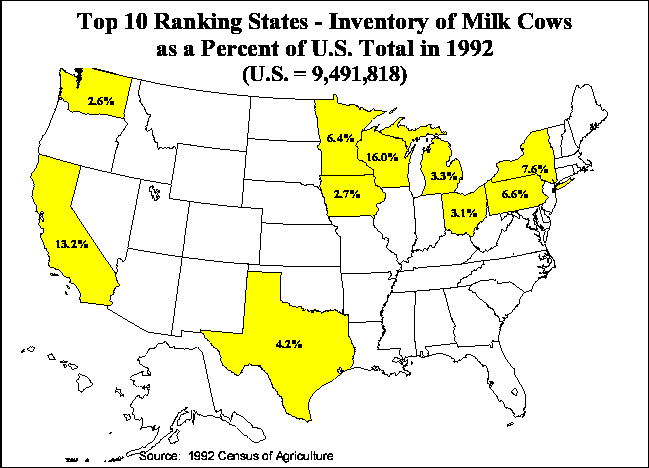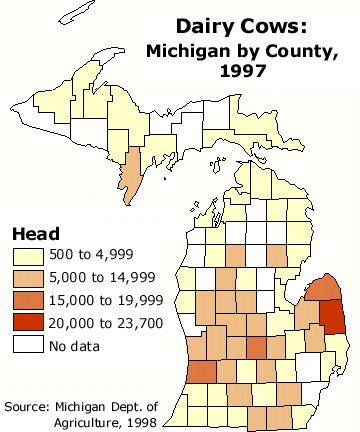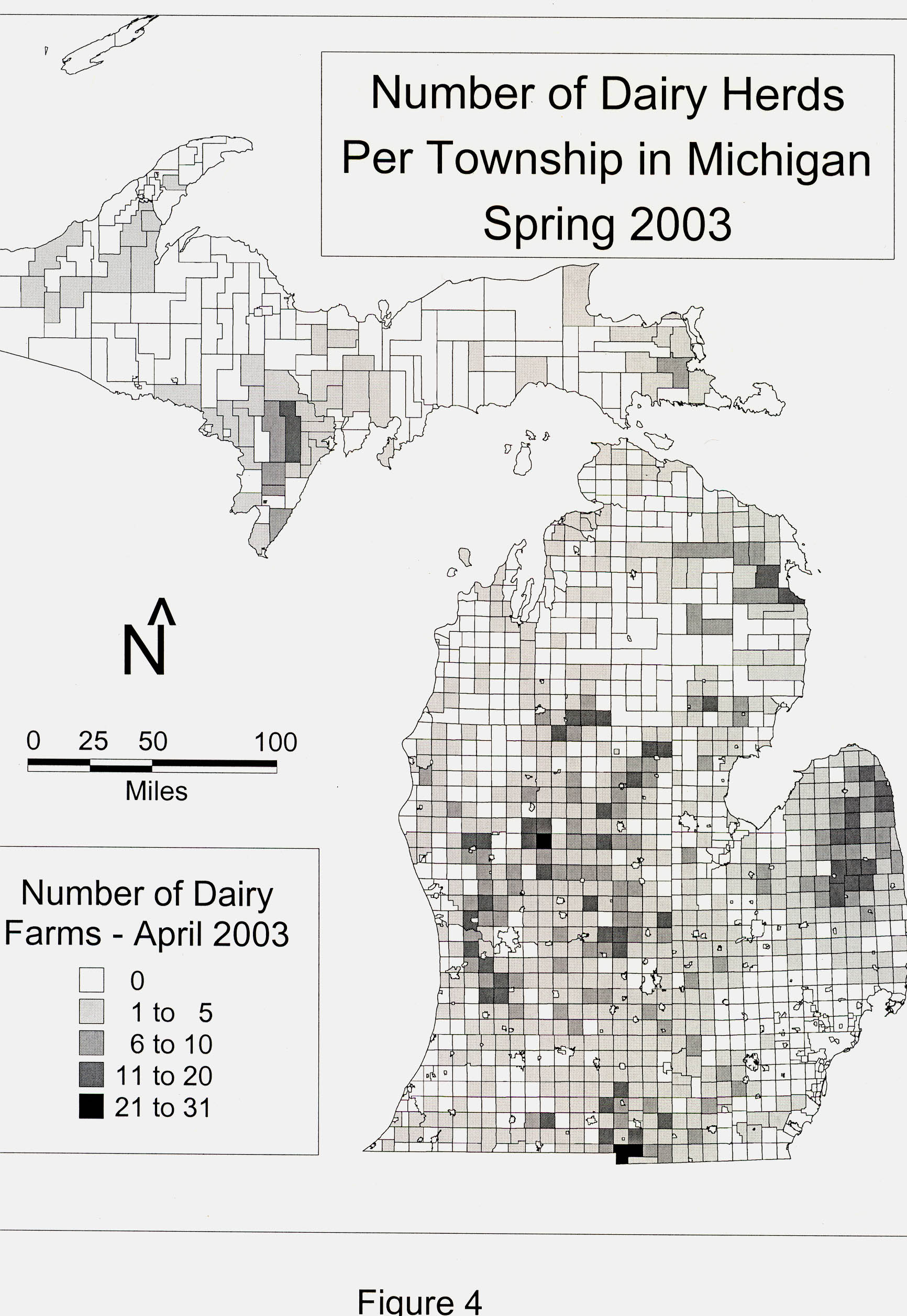DAIRYING
Dairy cattle were first brought to North America in 1624 to the Plymouth Colony, in what
is now Massachusetts. Wisconsin and California lead the United States in milk production.
Michigan is, however, one of the ten major dairy states. We rank 7th nationally in annual
milk production, accounting for 3.6% of the total US production.

About 326,000 cows produced 5.57 billion pounds of milk for Michigan and the world in
1995. Dairy farming is practiced throughout both peninsulas.
After her calf is born, a cow begins producing milk. This is called
"freshening." A cow can only freshen after she has given
birth to a calf. The first milk the cow gives is called colostrum, which contains
the nutrients and antibodies that the calf needs to stay healthy. The calf is weaned
immediately after birth and fed the mother's milk with a large nursing bottle.
Cows are milked by machine, usually twice a day, every 12 hours. If
they are milked at 3 p.m., they must also be milked at 3 a.m. Cows are milked for 305 days
or about 10 months. Then the cow's body needs to rest and store nutrients before she has
her next calf. After the calf is born, the cow will resume giving milk.
The average dairy cow produces 12,680 pounds of milk in 305 days.
That's nearly 1,475 gallons of milk. Milk is stored in refrigerated tanks at the dairy
farm until it is picked up by a refrigerated tank truck and taken to a dairy processing
plant. There the milk is homogenized and pasteurized and put into containers. Different
refrigerated trucks deliver the packaged milk to stores.
Milk and other dairy products provide 70 percent of the calcium in the
United States food supply, plus energy, protein and vitamins. Chocolate milk is made by
adding sweetener and chocolate or cocoa to whole milk and is an alternative for people who
don't drink white milk. Cheese, butter, ice cream, yogurt and sour cream are also made
from milk. It takes 10 pounds of milk to make one pound of cheese.
Dairy Cattle Nutrition
Most heifers are bred to freshen at two years of age. After they give birth, they join the
dairy herd and produce milk. The male calves are sold to feedlots, where they are fed
until they are taken to market for their meat.
Dairy cattle are ruminant animals with four compartments in their
stomachs; their digestive tract is the same as beef cattle. Dairy cows weigh 1,300 to
1,500 pounds and are fed high-quality feed. They eat grains such as ground corn, grain
sorghum, oats and soybean meal. Dairy cows also are fed forages, such as
high-quality alfalfa and whole corn plants (silage). A single cow can consume up to 20
lbs. of grain and 75 lbs. of hay each day. Water is another important nutrient for dairy
cows; every day they need to consume about 29 gallons of water or the equivalent of a full
bathtub.
Many dairy producers use computers in their feeding operations. The
computer reads the cow's identification and gives her a proper mix of grains, vitamins and
minerals. This is determined by her age and how much milk she produces.
Nintey-nine percent of all dairy cattle in the U.S. today are of the Holstein breed, which
are large-bodied with a black-and-white coat. The smaller-bodied breeds –
Guernsey, Jersey and Brown Swiss – give a high protein milk.
Although the maps below include ALL cows, it is safe to assume that most cattle in
Michigan are dairy cows rather than beef being raised for slaughter. About 1970,
milk cow distribution in Michigan looked like this:
Source: Unknown
By 1998, there were fewer cows in the state, and the distribution looked like this:


Source: Michigan State University Department of Geography
The map below, though a bit old, shows more specifically where dairying (regions #1, 4
and 6) is practiced. Knowing that this map is old, and the two maps above are more
recent, how do you think the dairy areas in Michigan have shifted, and why?

Source:
Hill, E.B., Riddell, F.T., and F.F.
Elliot. 1930. Types of farming in Michigan. Michigan Agricultural Experiment
Station Special Bulletin 206.
Here (below) is the most geographic recent data on dairying in Michigan:
Source: State of Michigan - Department of Agriculture
Thanks to John Cross for the dairy herd (2003) map.
This material has been compiled for educational use only, and may not be reproduced without permission. One copy may be printed for personal use. Please contact Randall Schaetzl (soils@msu.edu) for more information or permissions.